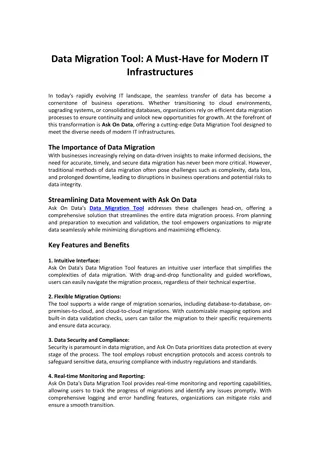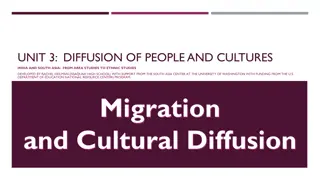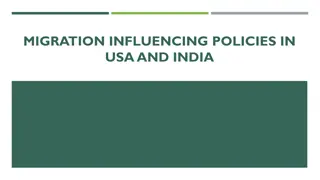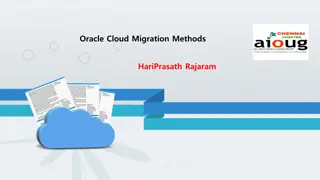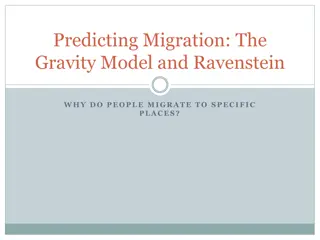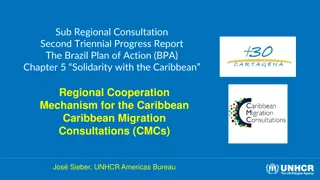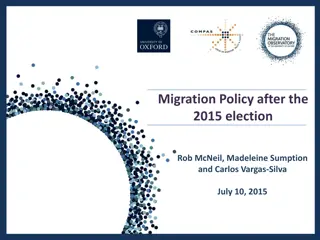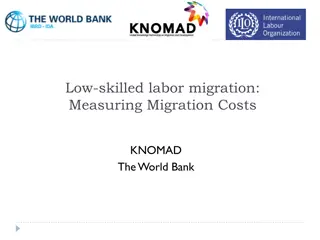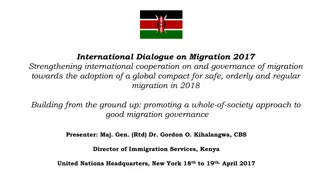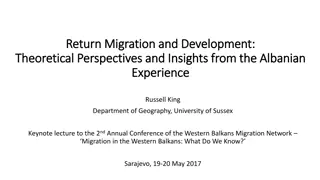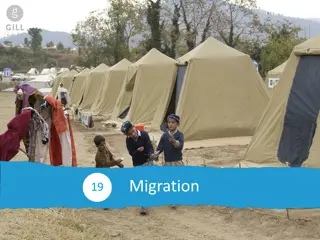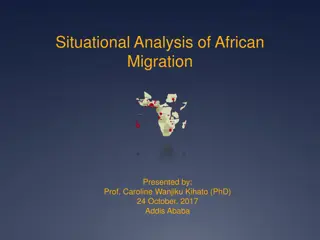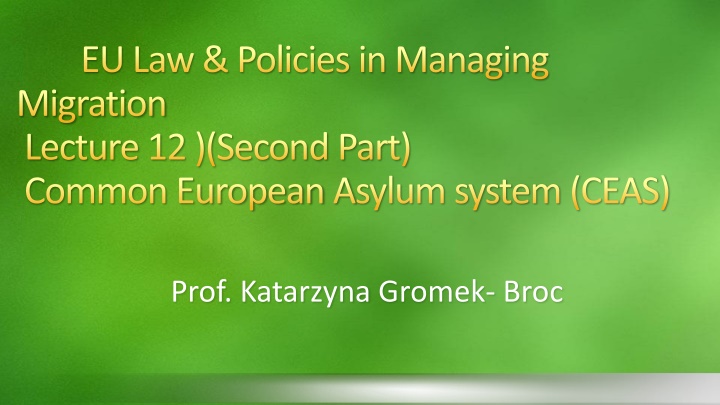
Common European Asylum System (CEAS) and Migration Policies
Explore the evolution and challenges of the Common European Asylum System (CEAS) through key milestones such as the Dublin Convention of 1990, the 2016 reform, and the New Pact on Migration & Asylum in 2020. Learn about the structure, directives, regulations, and the need for reform within the CEAS framework.
Download Presentation

Please find below an Image/Link to download the presentation.
The content on the website is provided AS IS for your information and personal use only. It may not be sold, licensed, or shared on other websites without obtaining consent from the author. If you encounter any issues during the download, it is possible that the publisher has removed the file from their server.
You are allowed to download the files provided on this website for personal or commercial use, subject to the condition that they are used lawfully. All files are the property of their respective owners.
The content on the website is provided AS IS for your information and personal use only. It may not be sold, licensed, or shared on other websites without obtaining consent from the author.
E N D
Presentation Transcript
EU Law & Policies in Managing Migration Lecture 12 )(Second Part) Common European Asylum system (CEAS) Prof. Katarzyna Gromek- Broc
ResearchQuestionand the content The content of the system How to make the system work? The problems in a current system The shortcomings of the 2016 reform (the third phase) New Pact on Migration & Asylum 2020 Phases Dublin Convention 1990 1 phase (early 2000) 2 phase (recast 2013) 3 phase (proposed reform 2016)
The content 1. Procedure Directive, 2. Qualification Directive, 3. Reception Conditions Directive, 4. Dublin III Regulation 5. EURODAC Regulation, two more decisions were added in 2015 on the relocation of asylum seekers from Greece and Italy Assisted by Temporary Protection Directive and Return Directive
Dublin System: origin Intergovernmental Group on Migration Ad hoc group on immigration: internal affairs & justice ministers 1986 Single European Act 1986 Turning point in the process of intergovernmental cooperation Dublin Convention - 1990
The beginning: The DublinConvention 1990 Convention determining the State responsible for examining applications for asylum lodged in one of the Member States of the European Community. Objectives: Identification of the State responsible for asylum procedure principle of authorisation ( one state one procedure ); Prevent applications filed in multiple states; Reduce the number of orbiting asylum-seekers Entered into force in September 1997 for the first 12 signatories (All EU Members)
The CEAS : Origin, content and the need for reform The origin of the CEAS Short historical steps: Amsterdam Treaty 1997: crucial for Migration Policy (Establishing an area of freedom, security and justice, Introduction of a new title Visa, asylum, immigration 1st pillar) Dublin Convention 1990: Why Convention? Lack of competence in the area of immigration
A reminder: EuropeanCouncils The Tampere Programme 1999. The European Council agreed to work towards establishing a Common European Asylum System (CEAS) based on the full application of the Geneva Convention The first phase of a CEAS (1999-2004) adoption of relevant legal instruments: Dublin Convention becomes Regulation no. 343/2003 (Dublin II Regulation), and adoption of Directives 2004/83/EC on minimum standards for the qualification as beneficiaries of international protection, Directive 2005/85/EC on minimum standards for procedures for granting and withdrawing refugee status Directive 2003/9/EC on minimum standards for the reception of asylum seekers
A reminder:EuropeanCouncils The Hague Programme The European Council set out the objectives to be implemented in the area of freedom, security and justice in the period 2005 2010 The Commission was invited to evaluate the first-phase of the CEAS and to present the second-phase instruments to the European Parliament and the Council
Origin: European Pact on Immigration and Asylum (Brussels, 24 September 2008) Objectives, inter alia, Creating a Europe of asylum : Set-up a European Asylum Support Office Ensure a single asylum procedure and a uniform status for refugees and beneficiaries of subsidiary protection Establish procedures to assist Member State receiving massive influxes of immigrants Strengthen collaboration with the UNHCR Train external border control personnel on the rights and obligation relating to international protection
The LisbonTreaty2009 Under Article 78 paragraph 1 : the Union shall develop a common policy on asylum, subsidiary protection and temporary protection in accordance with the Geneva Convention of 28 July 1951 and the Protocol of 31 January 1967 relating to the status of refugees
The LisbonTreaty2009 Article 78 paragraph 2 of the Lisbon Treaty The European Parliament and the Council ( ), shall adopt measures for a common European asylum system comprising: uniform asylum system uniform status of subsidiary protection common system for temporary protection for displaced persons common procedure for granting and withdrawing asylum determining Member State responsible for application for asylum standards for the reception of applicant for asylum or subsidiary protection partnership with 3rd countries to manage inflows
The CEAS The Content https://www.youtube.com/watch?v=XKxiEVYFo64 Dublin Regulation https://www.youtube.com/watch?v=7vst8xDDwvU 2020 Pact on Migration https://www.youtube.com/watch?v=DBeVdy7bU-M
Critics of Dublin II Regulation Reports drafted in 2013 upon the 10th anniversary of Dublin II Regulation, shown that it often acted to the detriment of refugees Areas of concern: excessive use of detention to enforce transfers of asylum seekers, separation of families, denial of an effective opportunity to appeal against transfers, serious delays in the examination of asylum claims, limited use of the discretionary provisions within the Regulation to alleviate these and other problems
2016 ProposedReform( PhaseIII) In May and in June 2016, the Commission put forward two packages of proposals for a reform of the CEAS. This is the biggest revamp of the system since its creation. The proposals intend to amend the Dublin III Regulation, to replace the EASO with the European Union Agency for Asylum, to modify EURODAC and again to revise the (Recast) Reception Conditions Directive, and finally to replace the Procedures and Qualifications Directives with Regulations and to adopt a New Regulation on Resettlement. The shift from the Directives to Regulations is particularly important for standardisation of the procedure and uniformity of practices across the EU.
Dublin Recast Regulation (Dublin III) The aim of the recast Dublin Regulation is to ensure that one Member State is responsible for the examination of an asylum application and deter multiple asylum claims General principles (Chapter II): - where it is impossible to transfer an applicant to the Member State designated as responsible because there are substantial flaws in the asylum procedure and in the reception conditions for applicants in that Member State, resulting in a risk of inhuman or degrading treatment within the meaning of Article 4 of the Charter of Fundamental Rights of the European Union, (...) the determining Member State shall become the Member State responsible (Art. 3.2)
DublinIII Regulation The application shall be examined by a single Member State identified based on the criteria set out in Chapter III (Art. 3.1). Where no Member State can be designated, the first Member State, the first Member State in which the application for international protection was lodged shall be responsible Criteria for determining the Member State responsible (Chapter III): particular rules for minor applicants (Art. 8) and families (Art. 9-11) state that issued a residence document or visa (Art. 12) state that the individual entered irregularly in the previous 12 months (Art. 13) state in which the individual lived on an irregular basis for 5 months (Art. 13)
DublinIII Regulation Safe third country (Art. 3.2): Any Member State shall retain the right to send an applicant to a safe third country, subject to the rules and safeguards laid down in Directive 2013/32/EU
DublinIII Regulation Discretionary clauses ( ), each Member State may decide to examine an application for international protection lodged with it by a third-country national or a stateless person, even if such examination is not its responsibility under the criteria laid down in this Regulation (Art. 17.1) Germany made use of the sovereignty clause in August 2015 to voluntarily assume responsibility for processing asylum applications from Syrian nationals.
DublinIII Regulation The process of determining the Member State responsible shall start as soon as an application for international protection is lodged with a Member State (Art. 20) Submitting a take charge request: Where a Member State with which an application for international protection has been lodged considers that another Member State is responsible for an application it may (in any event within 3 - or 2 - months of the day in which application was lodged), request the other Member State to take charge of the applicant (Art. 21) The requested Member State shall give a decision on the request to take charge within two 2 months of receipt of the request (Art. 22.1) Failure to act within the 2 months period is considered as the acceptance of the request and entails the obligation to take charge of the person (Art. 22.7)
DublinIII Procedural safeguards (Section IV) Notification of a transfer decision (Art. 26) Remedies (Art. 27) Detention for the purpose of transfer (Section V) Member State shall not hold a person in detention for the sole reason that he or she is subject to the procedure established by this Regulation (Art. 28) When there is a risk of absconding, Member State may detain the person concerned in order to secure transfer procedures ( ) (Art. 28) Detention shall be for as short period as possible and shall be for no longer than the time reasonably necessary to fulfil the required administrative procedure (...) (Art. 28.3)
Importantcase on DublinII ( in 2013 DublinIII notyetin force) Children: first country of entry different than the country where actually present (UK) two applications lodged (asylum shopping) The Question: who is dealing with the asylum application? The Court: deviates the first country rule in the best interests of the children Case C-648/11, MA, BT and DA v Secretary of State of the Home Department, 6 June 2013. (children asylum shoppers)
CJEU Case C-808/18 Commissionv Hungary 17/12/2020 The CJEU ruled that Hungary failed to fulfil its obligations under the recast Asylum Procedures, recast Reception Conditions and Return Directives. The CJEU s Grand Chamber examined several aspects concerning asylum applicants, including access to procedures, detention and return. It concluded that Hungary restricted access to the asylum procedure by imposing a law requiring applicants from the Serbian Hungarian border to access the procedure only through one of two transit zones, R szke and Tompa. Hungary also limited access by imposing limits on the number of third-country nationals authorised to enter the transit zones each day. In addition, Hungary did not respect the right to remain on the territory pending appeal procedures.
Reforms Since the migrant crisis started there are pressures to reform the Dublin system Communication from the Commission (COM(2016) 197 final): Option 1: Supplementing the present system with a corrective fairness mechanism: The current system of allocation of responsibility for examining asylum claim would be maintained but it would be supplemented with emergency distribution mechanism in case a Member State faces mass influx of 3rd country nationals Option 2: A new system for allocating asylum applications based on a distribution key: The responsibility would no longer be linked with the member state of first application or irregular entry. Responsibility would be primarily allocated on the distribution key reflecting the relative size, wealth and absorption capacities of the Member States
Relocation Schemes Relocation schemes established in September 2015 have also failed to produce results. Essentially because of three structural factors: (a) the unattractiveness of EU allocation schemes to protection seekers, due in particular to their strict no choice of destination philosophy; (b) in the absence of effective solidarity schemes, Member States tend to engage in defensive rather than cooperative behaviour; (c) a heavily bureaucratic approach, producing complexity and delays, compounded by the intergovernmental nature of responsibility allocation procedures.
QualificationDirective The Directive 2011/95/EU of 13 December 2011 on standards for the qualification of third-country nationals or stateless persons as beneficiaries of international protection, for a uniform status for refugees or for persons eligible for subsidiary protection, and for the content of the protection granted. It applies to all Member States with the exception of Denmark, Ireland and the United Kingdom (end of 2020). Ireland and the United Kingdom will continue to be bound by Directive 2004/83/EC (first phase of the same Directive)
RecastQualificationDirective It defines a European refugee as: a third-country national who, owing to a well-founded fear of being persecuted for reasons of race, religion, nationality, political opinion or membership of a particular social group, is outside the country of nationality and is unable or, owing to such fear, is unwilling to avail himself or herself of the protection of that country, or a stateless person, who, being outside of the country of former habitual residence for the same reasons as mentioned above, is unable or, owing to such fear, unwilling to return to it ( ) (Art. 2 (d)),
RecastQualificationDirective The Qualification Directive defines: Person eligible for subsidiary protection a third- country national or a stateless person who does not qualify as a refugee but in respect of whom substantial grounds have been shown for believing that the person concerned, if returned to his or her country of origin, or in the case of a stateless person, to his or her country of former habitual residence, would face a real risk of suffering serious harm ( ), and is unable, or, owing to such risk, unwilling to avail himself or herself of the protection of that country (Art. 2 (e));
RecastQualificationDirective The Qualification Directive defines actors of persecution (Art. 6): Actors of persecution or serious harm include: (a) the State (b) Parties or organisations controlling the State or a substantial part of the territory of the State (c) non-State actors, if it can be demonstrated that the actors mentioned in points (a) and (b), including international organisations, are unable or unwilling to provide protection against persecution or serious harm
RecastQualificationDirective The Qualification Directive defines acts of persecution (Art. 9.1): In order to be regarded as an act of persecution, within the meaning of Art. 1 (A) of the Geneva Convention, an act must: be sufficiently serious by its nature or repetition as to constitute a severe violation of basic human rights ( ) (prohibition of torture, prohibition of slavery, no punishment without law) be an accumulation various measures, including violation of human rights which is sufficiently severe as to affect an individual ( )
Recast Qualification Directive the concept of race shall include considerations of colour, descent, or membership of a particular ethnic group, the concept of religion shall include the holding of theistic, non-theistic and atheistic beliefs ( ), the concept of nationality shall not be confined to citizenship or lack thereof but shall include membership of a group determined by its cultural, ethnic, or linguistic identity (...), a group shall be considered to form a particular social group where: membership of that group share an innate characteristic, or a common background (...), that group has a distinct identity in the relevant country (...), (e) the concept of political opinion shall include the holding of an opinion, thought or a belief on a matter related to the potential actors of persecution (...)
Recast Qualification Directive Under Article 21 Protection from refoulement a Member State may refoule (return) a refugee when: there are reasonable grounds for considering him or her as a danger to the security of the MS in which he or she is present, or he or she, having been convicted by a final judgment of a particular serious crime, constitutes a danger to the community of that MS
QualificationDirective Content of international protection (Chapter VII): Residence permit (Art. 24) Travel documents (Art. 25) Access to employment (Art. 26) Access to education (Art. 27) Access to procedures for recognition of qualifications (Art. 28) Social welfare (Art. 29) Healthcare (Art. 30)
RecastProcedure Directive 2013/32/EU Directive on common procedures for granting and withdrawing international protection (Recast Procedures Directive) It sets out the standards for the Member States when examining applications for international protection made on the territory or at the borders, including the transit zones and the territorial waters It applies to all Member States with the exception of Denmark, Ireland and the United Kingdom(Brexit). Ireland and the United Kingdom will continue to be bound by Directive 2005/85/EC of 1 December 2005.
Procedure Directive Art 1: Purpose to establish common minimum standards for fair and efficient asylum procedures in the Member states Art 2 k) defines: subsidiary protection status means the recognition by a Member State of a third-country national or a stateless person as a person eligible for subsidiary protection; Art 3: Directive applies to all applications (subsidiary protection included) Art 23 envisages prioritised and accelerated procedures explained in Art 31(7) and 31 (8). Art 36: European Safe Country of Origin concept: designation of safe country is left with Member States. ( very controversial)
Procedure Directive Article 12: Guarantees for applicants Member States shall ensure that all applicants enjoy the following guarantees: (a) they shall be informed in a language which they understand the procedure and of their rights and their obligations. They shall be informed of the time-frame, the means at their disposal for fulfilling the obligation to submit the elements requested (b) they shall receive the services of an interpreter for submitting their case to the competent authorities whenever necessary. Member States shall consider it necessary to provide those services at least when the applicant is to be interviewed.
Procedure Directive The Directive is quite detailed on the issues and content of personal interview: Art 14-16 Art 14:The personal interview on the substance of the application may be omitted if the determining authority is able to take a positive decision with regard to refugee status on the basis of evidence available Article 26 on Detention does not exclude detention (quite weak in this respect) 1. Member States shall not hold a person in detention for the sole reason that he or she is an applicant. The grounds for and conditions of detention and the guarantees available to detained applicants shall be in accordance with Directive 2013/33/EU.
Reception ConditionsDirective 2013/33/EU Purpose: to lay down standards for the reception of applicants for international protection Art 2 Definitions: (f) reception conditions : means the full set of measures that Member States grant to applicants in accordance with this Directive; (g) material reception conditions : means the reception conditions that include housing, food and clothing provided in kind, or as financial allowances or in vouchers, or a combination of the three, and a daily expenses allowance.
Reception conditionsDirective 2013/33/EU Article 7 Residence and freedom of movement (can be limited: look) 1. Applicants may move freely within the territory of the host Member State or within an area assigned to them by that Member State. The assigned area shall not affect the unalienable sphere of private life and shall allow sufficient scope for guaranteeing access to all benefits under this Directive. Article 10 Conditions of detention (detention possible) 1. Detention of applicants shall take place, as a rule, in specialised detention facilities.
Reception ConditionsDirective 2013/33/EU Article 15. Employment 1. Member States shall ensure that applicants have access to the labour market no later than 9 months from the date when the application for international protection was lodged Article 19. Health care Member States shall ensure that applicants receive the necessary health care which shall include, at least, emergency care and essential treatment of illnesses and of serious mental disorders.
Reception Conditions Directive 2013/33/EU Article 25 (special treatment) Victims of torture and violence 1. Member States shall ensure that persons who have been subjected to torture, rape or other serious acts of violence receive the necessary treatment for the damage caused by such acts.


